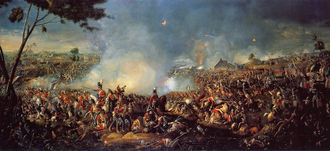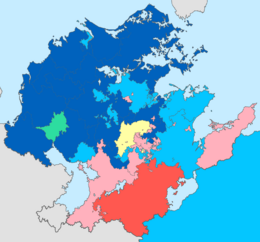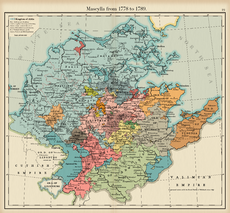War of the Five Kings: Difference between revisions
mNo edit summary |
No edit summary |
||
| Line 49: | Line 49: | ||
* {{flagicon image|Flag_of_Germany_(3-2_aspect_ratio).svg}} 12,496 | * {{flagicon image|Flag_of_Germany_(3-2_aspect_ratio).svg}} 12,496 | ||
}} | }} | ||
The '''War of the Five Kings''' ({{wp|German language|Hesurian}}: ''Krieg der fünf Könige''), also known as the '''Mascyllary War of Unification''' | The '''War of the Five Kings''' ({{wp|German language|Hesurian}}: ''Krieg der fünf Könige''), also known as the '''Mascyllary War of Unification''' (''Maskillischer Einigungskrieg''), '''Third Aldo-Adwhinish War''' (''Dritter Aldisch-Adwhinischer Krieg''), '''Brothers War''' (''Brüderkrieg''), or in Mascylla the '''Mascyllary War''' (''Maskillischer Krieg''), was the last {{wp|war}} between the [[Kingdom of Aldia]] and [[Kingdom of Adwhin]] and their respective allies in the [[Elbgau Confederation]] and remaining Mascyllary states, and ultimately culminated in the Aldian-led unification of Mascylla into the [[Mascyllary Kingdom]] following the war's end with the Treaty of Langquaid in 1793. | ||
In March 1789, the Grand Duke of Phalya, Charles IV, suddenly died but left no {{wp|heir apparent}} and the throne vacant. Aldia quickly suggested an [[House of Ahnern|Ahnern]] candidate, Lucas's brother Leopold, as Phalya's successor, but Adwhin, recognizing the strategic and economic importance of Phalya, aggressively objected and pushed for King Charles's nephew, Prince Maximilian, to succeed Charles IV. The issue quickly evolved into a diplomatic fiasco, and on 4 September 1789, Adwhin issued to resolve the conflict through war. | In March 1789, the Grand Duke of Phalya, Charles IV, suddenly died but left no {{wp|heir apparent}} and the throne vacant. Aldia quickly suggested an [[House of Ahnern|Ahnern]] candidate, Lucas's brother Leopold, as Phalya's successor, but Adwhin, recognizing the strategic and economic importance of Phalya, aggressively objected and pushed for King Charles's nephew, Prince Maximilian, to succeed Charles IV. The issue quickly evolved into a diplomatic fiasco, and on 4 September 1789, Adwhin issued to resolve the conflict through war. | ||
| Line 64: | Line 64: | ||
==Course of the war== | ==Course of the war== | ||
[[File:Map of the War of the Five Kings.png|260px|thumb|left|Sides and alliances of the War of the Five Kings:<br>{{colorbox|#0062BD}} [[Kingdom of Aldia]]<br>{{colorbox|#04C6FF}} Other [[Elbgau Confederation]] members<br>{{colorbox|#2DDDA0}} Neutral states (Birchau)<br>{{colorbox|#FFFEA5}} Disputed territory (Phalya)<br>{{colorbox|#FF5850}} [[Kingdom of Adwhin]]<br>{{colorbox|#FFB1BD}} Adwhinish allies]] | |||
==Negotiations and aftermath== | ==Negotiations and aftermath== | ||
===Treaty of Langquaid=== | ===Treaty of Langquaid=== | ||
Revision as of 12:19, 12 December 2022
This article is incomplete because it is pending further input from participants, or it is a work-in-progress by one author. Please comment on this article's talk page to share your input, comments and questions. Note: To contribute to this article, you may need to seek help from the author(s) of this page. |
| War of the Five Kings | |||||||||
|---|---|---|---|---|---|---|---|---|---|
 The Battle of Auserburg (7-8 May 1790) | |||||||||
| |||||||||
| Belligerents | |||||||||
|
| ||||||||
| Commanders and leaders | |||||||||
|
Franz Kohlner William of Oppenburg |
| ||||||||
| Strength | |||||||||
|
666,370
|
556,700
| ||||||||
| Casualties and losses | |||||||||
|
61,205
|
102,320
| ||||||||
The War of the Five Kings (Hesurian: Krieg der fünf Könige), also known as the Mascyllary War of Unification (Maskillischer Einigungskrieg), Third Aldo-Adwhinish War (Dritter Aldisch-Adwhinischer Krieg), Brothers War (Brüderkrieg), or in Mascylla the Mascyllary War (Maskillischer Krieg), was the last war between the Kingdom of Aldia and Kingdom of Adwhin and their respective allies in the Elbgau Confederation and remaining Mascyllary states, and ultimately culminated in the Aldian-led unification of Mascylla into the Mascyllary Kingdom following the war's end with the Treaty of Langquaid in 1793.
In March 1789, the Grand Duke of Phalya, Charles IV, suddenly died but left no heir apparent and the throne vacant. Aldia quickly suggested an Ahnern candidate, Lucas's brother Leopold, as Phalya's successor, but Adwhin, recognizing the strategic and economic importance of Phalya, aggressively objected and pushed for King Charles's nephew, Prince Maximilian, to succeed Charles IV. The issue quickly evolved into a diplomatic fiasco, and on 4 September 1789, Adwhin issued to resolve the conflict through war.
While Adwhin quickly invaded Phalya, the Elbgau Confederation was able muster a larger standing army under the command of Generalfeldmarschall William of Stenreck, supported by a growing number of civil militias trained and equipped by Aldia. The conflict quickly escalated into a full-scale war and it became apparent that the Elbgau Confederation and its allies would emerge victorious. After numerous victorious battles in Eustria and Phalya over the course of two years, the Battle of Auserburg in May 1790 was a decisive blow to the Adwhinish armies protecting the fortress of Auserburg, completely eradicating the bulk of its land army and capturing King Charles Anthony himself. While Aldia continued to advance further south, Franz Kohlner and a trail of thousands of petty soldiers, peasants and activists, collectively known as the "Expedition of the Thousands" (Zug der Tausenden) marched onto and invaded Breisgau, Adwhin's seat of governance.
Shortly thereafter, Adwhin capitulated without any peace terms and representatives of 20 Mascyllary states and free cities gathered in Langquaid to decide the political fate of Mascylla. Lucas I of Aldia was chosen to ascend the title of King of Mascylla, the Elbgau Confederation dissolved, and its member states as well as the defeated nations merged into a Mascyllary nation state. The treaty itself was signed and ratified on 18 May 1793 after months of negotiation. Subsequently, Lucas I was officially coronated in Langquaid to the largest audience of nobility in Mascylla's history on 23 May.
While the war itself was short, it left a devastating toll on the civilian population and southern economies who suffered from taxation, looting and sacking during the conflict. The government was largely composed of war veterans, such as William of Stenreck being elected as Mascylla's first Prime Minister, though former Adwhin and other southern states were deeply indebted, impoverished and virtually politically unrepresented, culminating in a series of strikes and riots in 1795 (Adwhinish Peasants' Revolt[3]) which were quickly put down by Aldian military forces. However, Mascylla witnessed an unprecedented economic rise, and Lucas I massively grew in public popularity with the introduction of a new row of statutes that satisfied the expanding middle class of classical liberalists and nationalists who continued to rise in influence in national politics and commerce, while the country's absolute monarchies were slowly replaced by constitutional systems.
Background
The destabilizing effect of the attempted civil revolutions throughout the state exacerbated tension between the two coalitions led by Aldia and Adwhin. The economic integration of the two blocs additionally led to a sharp increase in economic prosperity and wealth, but on the cost of the Elbgau Confederation needing natural resources and vital trade routes to continue its expanding economy, thus making a conflict due to the geopolitical and strategic importance of central Mascylla inevitable. The death of the aging Albert William I and the ascension of his son and heir, Lucas I who was vehemently in favor of national unification due to his father's efforts, was ultimately the turning point.
Course of the war

Kingdom of Aldia
Other Elbgau Confederation members
Neutral states (Birchau)
Disputed territory (Phalya)
Kingdom of Adwhin
Adwhinish allies
Negotiations and aftermath
Treaty of Langquaid
A rigorous debate erupted as to how the political system of Mascylla would actually be structured; a majority of states from the south who had a conservative point of view advocated for an enlightened, but absolute monarchy, while the peasantry, middle class and a number of northern states favored a democratic republic with a monarch as its figure head. Fearing the southern states would rebel and eventually secede from Mascylla, Lucas I drafted a compromise betweeen both parties, in which the monarch would have considerable power but be advised and kept in check by elected members of government. While this compromise resolved the ongoing dispute of Mascylla's governance, Lucas had own personal aspirations as a leader of power and therefore detested being removed political powers. Franz Kohlner as an influential political figure first strongly opposed his proposal, but reluctantly agreed later on, burying the nation-wide hopes of a civil state spurred by rising discontent in the Cuthish Empire and Falland in the 1790s for another century.
Another similar discussion arose after Lucas I proposed the title of "Emperor of Mascylla" (Kaiser Maskilliens) to Stenreck and his war cabinet who had voiced interest in the proclamation of an empire following Mascylla's unification in 1792. However, the absolute majority of the nobility outright refused this royal institution, mainly because of the vocal superiority and higher ranking of the title of emperor in comparison to those of kings or grand dukes which Lucas acknowledged would have irrefutably endangered the integrity of Mascylla's unity and aliented him from his "subordinates" of other royal heads. Furthermore, the existance and continuation of the Welsbach–Valimia personal union under then-respective Grand Duke and Emperor Charles Frederick II would have meant that Lucas I as Emperor of Mascylla would outrank Charles Frederick II as Emperor of Valimia, and Charles, as member of the Imperial Convention, electing any Mascyllary emperor was seen as offensive and politically ridiculed.
Ultimately, the treaty itself was signed and ratified on 18 May 1793 after months of negotiation. Lucas I was officially coronated in Langquaid to the largest audience of nobility in Mascylla's history on 23 May as "Mascyllary King" (Maskillischer König).
War aftermath
Part of a series on the |
|---|
| History of Mascylla |
 |
|
|
References
- ↑ The Valimian Empire and Grand Duchy of Welsbach were jointly ruled through the Welsbach–Valimia personal union from 1659 to 1923.
- ↑ Simultaneous Grand Duke of Welsbach and Emperor of Valimia since 1763.
- ↑ Hesurian: Adwhinischer Bauernaufstand
